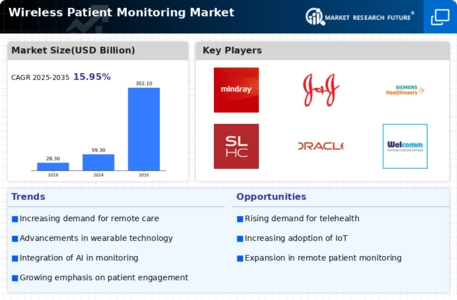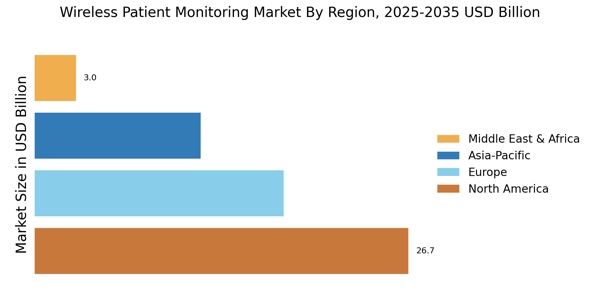Growing Aging Population
The Wireless Patient Monitoring Market is significantly influenced by the growing aging population, which is projected to reach 1.5 billion by 2050. This demographic shift creates a pressing need for innovative healthcare solutions that can cater to the unique health challenges faced by older adults. Wireless patient monitoring systems offer a practical solution, enabling elderly patients to receive care in the comfort of their homes while ensuring that healthcare providers can monitor their health status remotely. The convenience of these systems not only enhances the quality of life for seniors but also alleviates the burden on healthcare facilities. As the aging population continues to expand, the demand for wireless monitoring solutions is expected to rise, driving growth in the Wireless Patient Monitoring Market.
Rising Awareness of Health and Wellness
The Wireless Patient Monitoring Market is also experiencing growth due to the rising awareness of health and wellness among consumers. Individuals are increasingly taking proactive steps to manage their health, leading to a greater demand for monitoring solutions that provide real-time insights into their health status. This trend is reflected in the growing popularity of fitness trackers and health apps, which empower users to monitor various health metrics. As consumers become more health-conscious, the demand for wireless patient monitoring solutions is likely to increase, as these technologies offer a convenient way to track health progress. Consequently, the Wireless Patient Monitoring Market is expected to expand as more individuals seek to leverage technology for better health management.
Technological Innovations in Healthcare
Technological innovations play a pivotal role in shaping the Wireless Patient Monitoring Market. The advent of advanced sensors, wearable devices, and mobile health applications has revolutionized the way patient data is collected and analyzed. For instance, the integration of Internet of Things (IoT) technology allows for seamless connectivity between devices, enabling real-time data transmission to healthcare providers. This not only enhances the accuracy of health monitoring but also facilitates timely decision-making. Moreover, the market for wearable health devices is projected to reach USD 60 billion by 2025, indicating a robust growth trajectory. As these technologies continue to evolve, they are likely to drive further adoption of wireless monitoring solutions, thereby propelling the Wireless Patient Monitoring Market forward.
Rising Demand for Remote Patient Monitoring
The Wireless Patient Monitoring Market experiences a notable surge in demand for remote patient monitoring solutions. This trend is largely driven by the increasing prevalence of chronic diseases, which necessitate continuous monitoring and management. According to recent data, approximately 60% of adults globally live with at least one chronic condition, leading to a heightened need for effective monitoring solutions. The convenience and efficiency offered by wireless technologies enable healthcare providers to track patient health metrics in real-time, thereby improving patient outcomes. Furthermore, the integration of artificial intelligence and machine learning into monitoring devices enhances their predictive capabilities, allowing for timely interventions. As a result, the Wireless Patient Monitoring Market is poised for substantial growth, as healthcare systems increasingly adopt these technologies to meet patient needs.
Increased Investment in Healthcare Infrastructure
The Wireless Patient Monitoring Market benefits from increased investment in healthcare infrastructure, particularly in developing regions. Governments and private entities are recognizing the importance of modernizing healthcare systems to improve patient care and outcomes. This investment often includes the implementation of wireless monitoring technologies, which can enhance the efficiency of healthcare delivery. For example, initiatives aimed at expanding telehealth services are gaining traction, as they provide patients with access to healthcare professionals without the need for physical visits. As healthcare infrastructure continues to improve, the adoption of wireless patient monitoring solutions is expected to rise, further stimulating growth in the Wireless Patient Monitoring Market.


















Leave a Comment